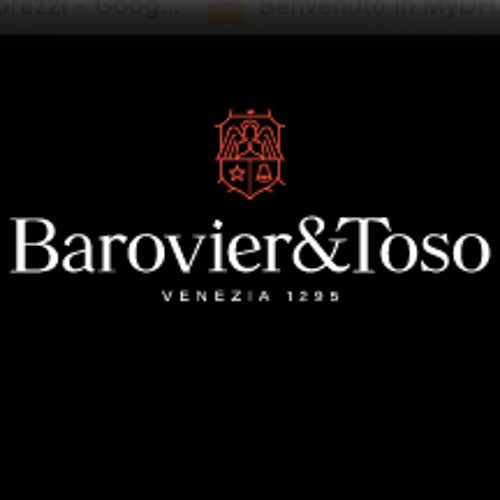The glasswork, founded in 1878, went through various circumstances before taking the current name of Barovier & Toso in 1942.
Owned by the Barovier family, together with more or less long-standing partners, under the leadership of Benvenuto and Giuseppe Barovier, it first took the name of Artisti Barovier producing glass type blown glass and articles with a vaguely Art Nouveau inspiration using multicoloured murrine.
This series includes the vases exhibited at the Mostra dei Fiori at Palazzo Ducale in 1914.
During the great war, as as indeed a number of other glass factories, the firm moved to Livorno (Italy) and when it returned to murano in 1919, it become Vetreria Artistica Barovier, headed by Ercole and Nicolo' Barovier.
The firm took part in 1923 in the First International Exhibition of decorative Arts in Monza, where, next to a series of murrine vases and classical brown wares, it exhibited a series of connubio di vetro e ferro in which the wrought iron parts were made by the Venice firm Cardin & Fontana.
The firm's creative soul was Ercole Barovier, active over a period stretching from 1922 to 1972. The heir of one of the oldest Murano glassblowers families, he created more than 23,000 glass models, often inventing outright a number of manufacturing processes that contributed a great deal to the renewal of glassmaking art. Already during the 20s he met with great success, first with murrine vases, on designs by Zecchin and Wolf Ferrari, later with altogether autonomous creations, widely praised even by Gio' Ponti in the pages of "Domus". One of his most successful creations was the primavera glassware, a limited series that could not be repeated, exhibited at the 1930 Biennale. During the 30s when he dedicated himself with a great passion to research in the sector of heavy glasswares, he created a whole series of objects characterised by the use of very thick materials, with the inclusion of various substances to create multicoloured reactions, defined in one of his patents as: colorazione a caldo senza fusione, a technique that, with a number of modifications, he used later even during the 50s. The most significant series of his production were: "autunno gemmato", "marina gemmata", "laguna gemmata".
He participated with great success in the main exhibitions in Italy and abroad and everywhere he was awarded prizes and recognition, such as the Grand Prix at the 1937 International Exhibition in Paris. Ercole Barovier made a particulary interesting use of very thick colourless glass, enhancing it with application, iridescenza and a bollicine.
The year 1938 saw the creation of "rostrati", glassware with large regular pointed tips that refract light. These models were much copied by other glass factories, and they were always the object of long legal disputes. The series: "mugnoni", "medusa", "bugnati", "lenti", "superbolle" that appeared in the immediately subsequent years also belong to this kind of glassware. In 1936 the furnace merged with S.A.I.A.R. Ferro-Toso firm, taking the name of Ferro-Toso-Barovier: this name was kept until 1939, when it was changed to Barovier-Toso & Co., while in 1942 it took the current name of Barovier & Toso.
The year 1940 was particularly significant as, at the Milano (italy) Triennale, several series of glasswares were exhibited such as "rugiada", "groviglio", " Oriente", "rilievi aurati", "rilievi argentati". After the war Ercole barovier abandoned the use of thick materials little by little and turned his interests to research in the field of decorative techniques. The articles of those years, if we want to try and define a common line, were characterized by fairly simple - or archaic - formswhile all the creative efforts tended to experiment with new uses of traditional techniques, such as the murrine, for example, but obtaining chromatic effects that were absolutely new and extremely current. We can highlight here his tessera vases, the "Corinto" and "Damasco" vases, the "saturnei" exhibited at the 1951 Milano (italy) Triennale and then all the variations of the tessera vases: "millefili", "Sidone", "parabolici", "moreschi", "Micene", "a spina".
Another constant line throughout those years was represented by glassware that exploited the technique of colorazione a caldo senza fusione, whose most notable examples were the "barbarici" exhibited at the 1951 International Glass Exhibition in Paris, the "eugenei", the "neolitici", the "aborigeni" glassware. In the early 60s Ercole Barovier returned in full to the murrine technique and proposed some completely new versions of these, such as the "Argo", "dorici", "a intarsio", "caccia" glassware, exhibiting the latter at the 1962 Biennale.
Among the last creations of these great glassware artist we can remember the "siderei", "Athena", the "rotellati" and the "neomurrine" glassware in 1972 that represented his last work. Toward the end of the 50s his son Angelo worked with him as a designer.
Some creations exhibited at the 1960 Biennale were attributed to him, such as the "polivasi". The son's research activity also involved the field of painting but always seen as an application of glassmaking techniques.
Beginning in the 80s the firm of Barovier & Toso also used external designers such as Matteo Thun and Toni Zuccheri .
The firm is still active under the management of Angelo Barovier, Jacopo Barovier and Giovanni Toso. Works by the Barovier & Toso glass factory are on show in practically all the most important museums throughout the world and in many private collections.



Leave a comment
All comments are moderated before being published.
This site is protected by hCaptcha and the hCaptcha Privacy Policy and Terms of Service apply.